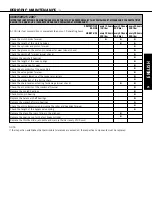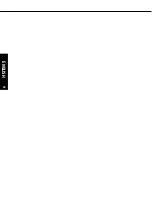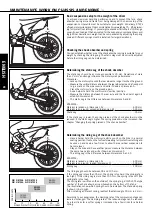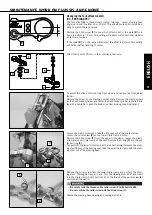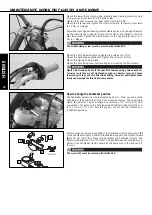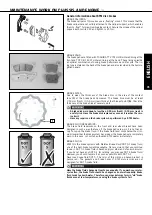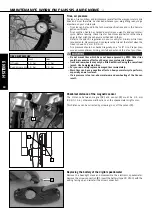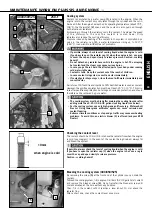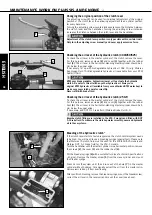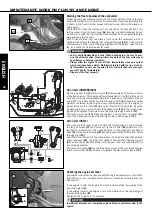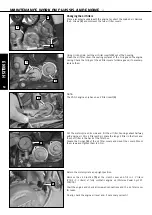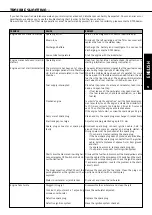
MAINTENANCE WORK ON CHASSIS AND ENGINE
»
ENGLISH
36
5 mm
min. 3 mm
1
3
2
4
min.
1 mm
Adjusting the free travel at the hand brake lever
Free travel at the hand brake lever may be readjusted by using adjustment
screw
[1]
. In this way, the position of the point of pressure (i.e. the resis-tance
you feel on the hand brake lever when the brake pads are pressed against the
brake disc) can be adjusted for any hand size.
When you press the hand brake lever forwards, you should have at least
3 mm free travel. Turn the adjusting screw
[1]
if necessary.
At the hand brake lever, free travel must at least be 3 mm (0.1 in). Only then
may the piston in the hand brake cylinder be moved (to be recognized by the
greater resistance of the hand brake lever). If this free travel is not provided,
pressure will build up in the braking system, and the front-wheel brake may
fail due to overheating.
Checking the brake fluid level - front brake
The brake fluid reservoir is linked with the hand brake cylinder at the handle-
bar and the reservoir is provided with an inspection glass. With the reservoir
in a horizontal position, the brake fluid level should not drop below the
middle of the glass.
If the brake fluid level drops below the minimum either the brake system has
a leak or the brake pads are completely worn. In this case, consult an author-
ized KTM dealer immediately.
Refilling the front brake fluid reservoir *
Loosen screws
[2]
and remove lid
[3]
and membrane
[4]
.
Place hand brake cylinder in a horizontal position and fill the brake fluid reser-
voir to 5 mm (0.2 in) below the rim with clean brake fluid DOT 5.1 (e.g. Motorex
Brake Fluid DOT 5.1). Replace membrane and lid, tighten screws. Rinse off
spilled or overflowing brake fluid with water.
– Never use DOT5 brake fluid! It is based on silicone oil and of a purple
color. Seals and brake hoses must be especially adapted to it.
– Store brake fluid out of reach of children.
– Brake fluid can cause skin irritation. Avoid contact with skin and eyes. If
you get brake fluid in your eyes, rinse with plenty of water and consult a
doctor
– Don’t let brake fluid get in contact with paint, it is an effective paint remover.
– Use only clean brake fluid taken from a tightly sealed container.
Checking the front brake pads
The brake pads can be inspected from below. The linings must be at least
1 mm (0.04 in) thick.
At their most worn point brake pad linings should not be thinner than 1 mm,
otherwise they could lead to brake failure. For your own safety don’t put off
having your brake pads changed.
If the brake pads are replaced too late so that the lining is partly or entirely
worn, the steel components of the brake pad will rub against the brake disc,
thereby imparing the braking effect and destroying the brake disc.
Summary of Contents for 2007 250 EXC-F SIX DAYS
Page 27: ...ENGLISH 26 ...
Page 63: ...ENGLISH 62 ...




